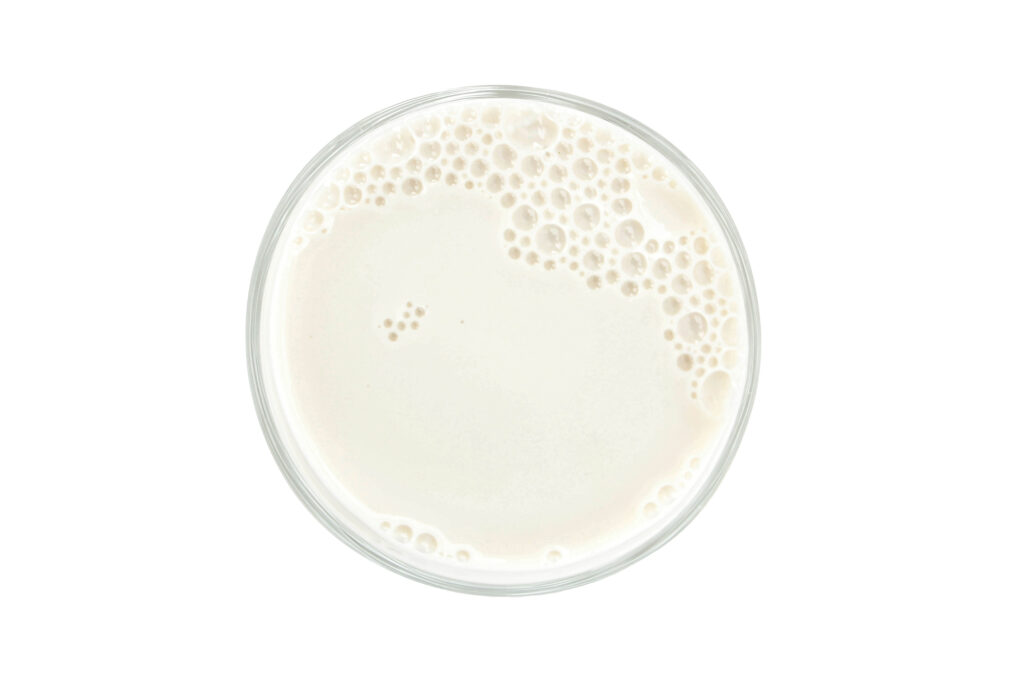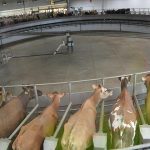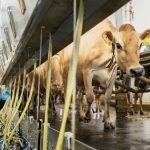
Pour yourself a frothy glass of 2% as we explore The Dairy State’s namesake product.
At some point, milk was overtaken by cheese as being synonymous with Wisconsin.
Maybe it was in 1987. That’s when Milwaukeean Ralph Bruno invented what has become the unfortunately ubiquitous foam Cheesehead. Or 1993, when California surpassed America’s Dairyland in milk production.
But Americans’ milk drinking has actually been in decline ever since the USDA began tracking it in 1975. It’s now at an all-time low. Oat, almond, soy, coconut and, yes, hemp alternatives are supplanting dairy milk; in a recent study, 29% of consumers exclusively purchased or dabbled in dairy alternatives.
Meanwhile, annual cheese consumption is at a record high (nearly 42 pounds per person).
It’s not that folks aren’t interested. Google searches for milk – and milk in regard to health in particular – have trended upward dating back to 2004, which is as far back as Google Trends goes.
So, with the approach of World Milk Day on June 1, consider:
Our state is a dairy powerhouse.
Wisconsin’s 1.27 million dairy cows – including more than 29,000 in Ozaukee, Washington, Waukesha and Racine counties – produce 25,000 pounds of milk per cow – 14% of the nation’s milk supply. Wisconsin also leads the nation in the number of milk goats, but that’s a relatively paltry 72,000. Wisconsin milk sales totaled $7.78 billion in 2022, up 32% from the previous year (based almost entirely on stronger prices).
Milk is recommended for good nutrition.
The USDA recommends daily intake of dairy, including low-fat or fat-free milk, but only about 20% of adults drink milk daily. Fortified soy beverages can provide the same nutritional benefits, but other alternatives don’t.

Parents want milk for their kids.
Morning Consult did an online national poll of parents with children in public school in January. It found that four out of five parents said whole and 2% milk are healthy and nutritious; and 90% said drinking milk daily is very or somewhat important for children’s nutrition.
Will schools shift to more milk?
Schools can’t offer whole milk – only fat-free or low-fat (1%) – with school breakfasts and lunches, under USDA regulations set in 2012. The rules were to “enhance the diet and health of school children, and help mitigate the childhood obesity trend.” But the U.S. House in December approved a bill that would allow schools to serve whole milk. The bill has not been taken up by the Senate.
Health risks are unclear.
Tens of millions of Americans are lactose intolerant (gas, bloating, diarrhea), a condition especially prevalent among people of Asian and African origin. But it’s not clear that milk, long known as “nature’s perfect food,” is inherently unhealthy, according to two leading public health news sources. Healthline reported that milk is linked to an increased risk of certain cancers but controls appetite, promotes bone and dental health, and can prevent diabetes. KFF News concluded, “There appears to be little consensus on the health risks of whole milk.”
How Do Businesses Producing Milk Remain Profitable?
Here’s what Wisconsin dairy farmers worry about year over year:
Milk Prices: The pricing of milk is quite complicated – federal regulations set the prices each year, and those prices are known to fluctuate significantly. In 2024, the price is dropping, with $19 per hundred pounds of milk (about 11.6 gallons) reported in February. Recent February prices have ranged from $23.90 in 2022 to $17.30 in 2021.
Labor: Dairy farms require skilled labor, and like many industries, the demand is high and the supply is low right now. Plus, training a new laborer can take up to two months. Some Wisconsin farmers are in favor of the Farm Workforce Modernization Act, a federal bill that would create a year-round visa for immigrant farmworkers.
Weather: With a drought hitting in the middle of the summer, 2023 was a bad year for weather on Wisconsin farms. The effects of that will persist into 2024, but as of early 2024, experts were forecasting an equal chance for normal precipitation or dry conditions.
Congress: The national 2018 Farm Bill, which implements a complex series of subsidies and other programs for farmers, remains in effect through September of this year. Congress, and the president, will have to decide whether to extend it again or enact a new, updated bill which could change the subsidy structure – for better or worse – on which farmers rely.
The Cali Competition
The year was 1993, a brutal, heartbreaking, orbit of the Earth around the sun. California produced 22.9 billion pounds of milk, and Wisconsin produced 22.8 billion, and with that the Golden State overtook the Dairy State in milk production, a position it still holds today.
This is more a story of California’s aggressive pursuit of milk than Wisconsin’s failing. Wisconsin’s milk production declined about 3 billion pounds in the late ’80s and early ’90s, while California’s has absolutely boomed since the ’70s, taking advantage of abundant land in its central region using a highly concentrated and industrialized model milk production.
Today, California has about 1,100 California dairy farms, with 1.72 million milking cows. Wisconsin, on the other hand, has many more small, family farms, with a little over 6,000 total, milking about 1.3 million cows.
That kind of density casts some doubt on the “Happy Cows come from California” campaign from years back. Still, the gap in production remains significant, with California outproducing Wisconsin 41.8 billion pounds to 31.9 billion in 2022.
The Other ‘Milks’
Surveys find that milk drinkers choose cow milk mainly because of taste, whereas milk-alternative consumers are driven more by health considerations, according to McKinsey & Co.
But what if you want to choose based on the environment?
Compared with cow’s milk, plant-based milks, including soy, oat, almond, coconut, rice, pea and cashew, are more expensive – but they are generally associated with lower environmental impacts.

When you think that a single cow, weighing an average of 1,400 pounds, belches and toots about 220 pounds of methane a year, it’s not surprising that that amounts to three times as much greenhouse gas emissions as plant alternatives.
And production of dairy milk (which is 87% water, mixed with protein, lactose, fat and minerals) uses two to 20 times as much freshwater as the alternatives. Almond milk had the highest water inputs among plant-based milks – about 13 times that of soy milk but 60% that of dairy milk.
No milk alternative stands out as environmentally superior, but Sentient Media, which reports on the impact of factory farms, offered a scorecard. It crowned soy as best, due to its low land use, water use and greenhouse emissions.
You can now read the most important #news on #eDairyNews #Whatsapp channels!!!
🇺🇸 eDairy News INGLÊS: https://whatsapp.com/channel/0029VaKsjzGDTkJyIN6hcP1K























